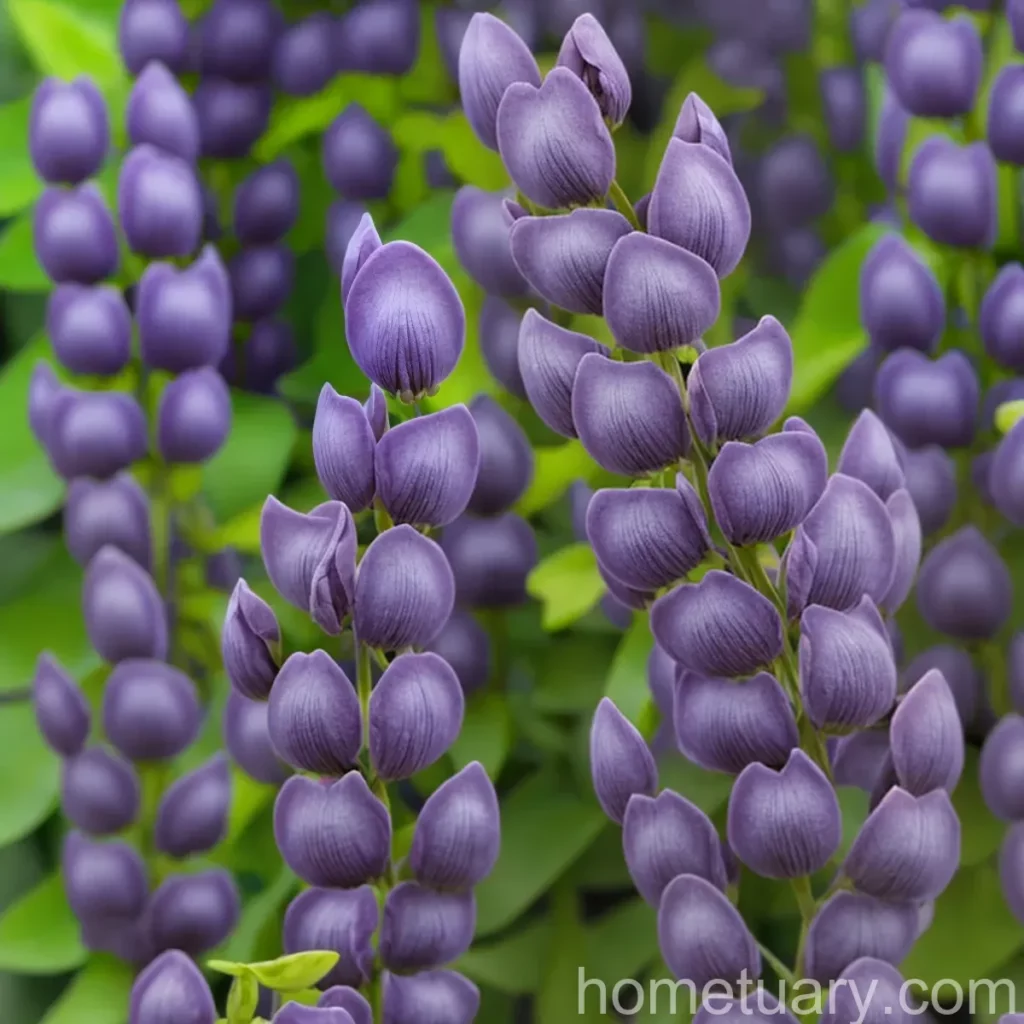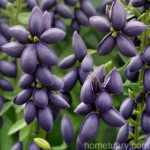False Indigo (Baptisia ‘Dutch Chocolate’): A Versatile and Beautiful Perennial
False indigo, also known as Baptisia ‘Dutch Chocolate’, is a stunning flowering perennial that belongs to the legume family. This native plant is known for its beautiful flowers, drought-tolerant nature, and its ability to attract wildlife. In this comprehensive guide, we will delve into the culture, uses, care, and maintenance of false indigo, providing you with all the necessary information to grow and enjoy this versatile plant in your garden.
What is False Indigo (Baptisia ‘Dutch Chocolate’)?
False indigo, scientifically known as Baptisia ‘Dutch Chocolate’, is a herbaceous perennial plant that boasts beautiful spikes of deep purple flowers. This cultivar is a member of the Baptisia genus, and it is a hybrid resulting from the crossing of various Baptisia species. The ‘Dutch Chocolate’ variety is particularly prized for its exceptional flower color and attractive foliage.
Key Takeaways – False Indigo (Baptisia ‘Dutch Chocolate’)
Before we delve into the detailed aspects of growing and caring for false indigo, let’s quickly summarize the key takeaways about this stunning perennial:
- Plant Name: False Indigo (Baptisia ‘Dutch Chocolate’)
- Common Names: Dutch Chocolate false indigo, False indigo flower
- Plant Type: Perennial
- Family: Leguminosae/Fabaceae
- Native: North America
- Key Features: Drought-tolerant, low-maintenance, nitrogen-fixing, wildlife-friendly, stunning flowers
- Hardiness Zones: 4-9
- Uses: Landscaping, wildlife gardens, pollinator gardens, cut flowers
- Attracts: Bees, butterflies, and other pollinators
- Foliage Color: Dark green
- Flower Color: Deep purple
Now that we have established the basics, let’s dive into the various aspects of growing and caring for false indigo in your garden.
Culture
Water
False indigo is known for its remarkable drought tolerance. Once established, it can thrive in dry conditions and requires minimal watering. In fact, excessive moisture can lead to root rot, so it is essential to ensure that the soil is well-draining. During the plant’s establishment phase, it is crucial to provide regular watering to help the roots develop and to ensure healthy growth. However, once the plant is established, it generally thrives with little to no supplemental watering, making it an excellent choice for water-wise gardens and xeriscaping projects.
Sunlight
False indigo thrives in full sun to partial shade. It is essential to provide at least 6 hours of direct sunlight for optimal flowering and overall vigor. However, it can also tolerate light shade, making it quite versatile in various garden settings. When grown in partial shade, it may exhibit slightly fewer flowers, but the overall plant health and vigor remain strong.
Fertilizer
One of the remarkable features of false indigo is its ability to thrive in nutrient-poor soils. As a member of the legume family, it has the unique ability to fix nitrogen from the air, enriching the soil around its roots. This nitrogen-fixing ability makes it a valuable plant in sustainable gardening practices as it reduces the need for synthetic fertilizers and promotes soil health. However, if the plant shows signs of nutrient deficiency, a top dressing of compost or a balanced organic fertilizer in early spring can support its growth and flowering.
Soil
False indigo prefers well-draining, sandy loam to loam soils. It is tolerant of a wide range of soil pH, from slightly acidic to slightly alkaline. However, it is important to avoid waterlogged or heavy clay soils, as these can lead to root rot and other issues. Amending heavy soils with organic matter, such as compost or well-rotted manure, can improve drainage and provide essential nutrients to the plant.
Pruning
False indigo typically requires minimal pruning. However, deadheading the spent flowers can encourage prolonged blooming and prevent self-seeding. In late fall or early spring, it is advisable to cut back the stems to ground level to rejuvenate the plant and promote a tidy appearance for the coming growing season. Additionally, removing any damaged or diseased stems can help maintain the plant’s overall health and appearance.
Propagation
False indigo can be propagated through various methods, including seed sowing and division.
Seed Sowing
- Harvesting Seeds: Collect the mature seed pods in late summer or early fall once they turn brown.
- Seed Treatment: To enhance germination, scarify the seeds by lightly sanding or nicking the hard seed coat.
- Sowing: Plant the seeds in a well-draining seed starting mix, and keep them consistently moist until germination occurs.
- Transplanting: Once the seedlings have developed several sets of true leaves, they can be transplanted into individual pots or directly into the garden.
Division
- Timing: Division is best done in early spring as new growth begins.
- Process: Carefully dig up the clump, ensuring that you include a good portion of the root system.
- Separation: Use a sharp, clean knife to divide the clump into smaller sections, each containing several healthy shoots and a portion of the root system.
- Replanting: Replant the divisions at the same depth as the original plant, and water them thoroughly to help establish their roots.
Container Popularity
False indigo can also be grown in containers, making it an excellent choice for patios, balconies, and small gardens. When choosing a container for false indigo, it is important to select one that provides adequate drainage and sufficient space for the plant’s roots to develop. A sizeable, sturdy container that is at least 18 inches in diameter and depth is typically recommended for a healthy and happy false indigo plant. Additionally, using a well-draining potting mix specially formulated for perennial plants can support the plant’s growth and overall health.
Common Diseases
False indigo is generally resistant to most pests and diseases. However, like all plants, it can be susceptible to certain issues, especially in conditions that are not ideal for its growth. Here are some common diseases and issues that may affect false indigo:
Disease Diagnosis
- Root Rot: This can occur in waterlogged or poorly draining soils. Symptoms include wilting, yellowing foliage, and stunted growth.
- Powdery Mildew: This fungal disease appears as a powdery white substance on the leaves. It is typically caused by poor air circulation and high humidity.
- Leaf Spot: This can manifest as dark spots on the foliage, often caused by prolonged periods of wetness on the leaves.
Common Pests
False indigo is relatively resistant to most pests. However, occasional issues with aphids or spider mites may occur, especially in hot and dry conditions. These can typically be managed with insecticidal soap or horticultural oil sprays, and by encouraging natural predators such as ladybugs and lacewings.
Botanist’s Tips
Growing False Indigo Successfully
- Suitable Planting Time: It is best to plant false indigo in the spring or early fall, providing the roots with ample time to establish before harsh weather sets in.
- Mulching: Applying a layer of organic mulch around the base of the plant can help conserve moisture and moderate soil temperatures.
- Supporting Structure: Taller varieties of false indigo may benefit from staking or support to prevent the stems from flopping, especially when in bloom.
- Overwintering Care: In colder climates, consider applying a layer of mulch or straw over the plant in late fall to protect it from harsh winter conditions.
Fun Facts
- The genus name “Baptisia” is derived from the Greek word “bapto,” meaning “to dye.” This is in reference to the historical use of the plant’s roots as a natural dye.
- False indigo has been used traditionally for its medicinal properties, primarily by Native American tribes. The roots were used to create herbal remedies for various ailments.
Links to External Resources
For additional information on false indigo, and to explore further resources, I recommend the following links:
- The Royal Horticultural Society (RHS) Guide to Cultivating Baptisia – RHS Baptisia Guide
- Missouri Botanical Garden Plant Finder – Missouri Botanical Garden Baptisia ‘Dutch Chocolate’ Page
- The National Gardening Association’s Guide to Growing Baptisia – NGA Baptisia Growing Guide
- University of Florida IFAS Extension Guide to False Indigo – UF/IFAS False Indigo PDF
In conclusion, false indigo (Baptisia ‘Dutch Chocolate’) is a versatile, low-maintenance, and visually stunning perennial plant that holds a special place in both natural and cultivated landscapes. With its gorgeous deep purple flowers, tolerance to a wide range of conditions, and its ability to attract beneficial wildlife, it is a valuable addition to any garden. Whether you are a beginner gardener or a seasoned horticulturist, adding false indigo to your garden can bring joy and beauty while contributing to sustainable and wildlife-friendly gardening practices.
As a plant scientist, I am always intrigued by the remarkable adaptability and unique traits that plants exhibit, and false indigo certainly captivates with its exceptional qualities. I hope this comprehensive guide has provided you with valuable insights into the captivating world of false indigo and has inspired you to explore the possibilities of growing this exceptional perennial in your garden. If you have any questions or experiences to share about cultivating false indigo, feel free to leave a comment below. Happy gardening!















